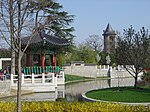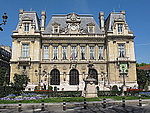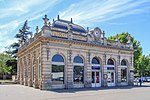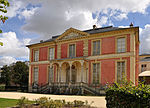Musée national des Arts et Traditions Populaires (France)
The Musée national des Arts et Traditions Populaires was a museum of the popular arts and traditions of France. It was located in a building at 6, avenue du Mahatma Gandhi, Paris, France, which was closed to the public in 2005. Its collections were transferred to the Musée des Civilisations de l'Europe et de la Méditerranée in Marseilles. The museum was created in 1937 by Georges-Henri Rivière as the French section of the Trocadéro's Musée de l'Homme, in the basement of which it was open in 1951. In 1969 it moved to its own building, designed by architect Jean Dubuisson and set beside the Jardin d'Acclimatation (Porte des Sablons) in the Bois de Boulogne. Over the years its initial focus on traditional agricultural France broadened to include contemporary urban culture and popular entertainment (notably circus) with collections of French crafts and peasant civilisation, home furniture, agricultural tools, industrial and artisanal items, photographs and printed materials, and costumes. In 2017, the City of Paris decided to revamp and partially redesign its original building in the Bois de Boulogne (which had been left vacant), and relocate the collections of the Musée des Arts et Tradition Populaires in their original home. The work on the building will be privately financed by the Group LVMH, and led by the architect Frank Gehry, with the collaboration of Thomas Dubuisson, grandson of the original architect, Jean Dubuisson. The building should reopen in 2020.
Excerpt from the Wikipedia article Musée national des Arts et Traditions Populaires (France) (License: CC BY-SA 3.0, Authors).Musée national des Arts et Traditions Populaires (France)
Route de la Porte Dauphine à la Porte des Sablons, Paris 16th Arrondissement (Paris)
Geographical coordinates (GPS) Address Phone number Website Nearby Places Show on map
Geographical coordinates (GPS)
| Latitude | Longitude |
|---|---|
| N 48.877222222222 ° | E 2.2677777777778 ° |
Address
Jardin d'Acclimatation
Route de la Porte Dauphine à la Porte des Sablons
75116 Paris, 16th Arrondissement (Paris)
Ile-de-France, France
Open on Google Maps







